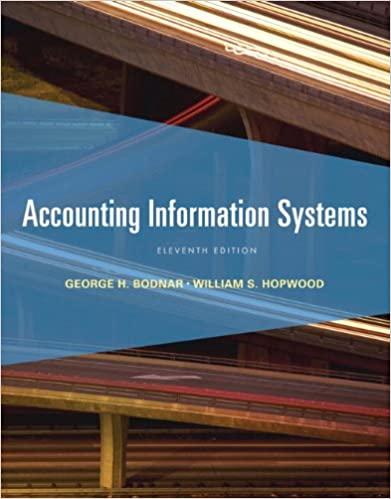1. A sales clerk at Schackne Company correctly prepared a sales invoice for $ 5,200, but the...
Question:
a. Use predetermined totals to control posting routines.
b. Have an independent check of sales invoice serial numbers, prices, discounts, extensions, and footings.
c. Have the bookkeeper prepare monthly statements that are verified and mailed by a responsible person other than the bookkeeper.
d. Have a responsible person, who is independent of the accounts receivable department, promptly investigate unauthorized remittance deductions made by customers or other matters in dispute.
2. For good internal control, the billing department should be under the direction of the
a. Controller.
b. Credit manager.
c. Sales manager.
d. Treasurer.
3. Which of the following controls most likely would be effective in offsetting the tendency of sales personnel to maximize sales volume at the expense of high bad- debt write- offs?
a. Employees responsible for authorizing sales and bad-debt write- offs are denied access to cash.
b. Shipping documents and sales invoices are matched by an employee who does not have authority to write off bad debts.
c. Employees involved in the credit- granting function are separated from the sales function.
d. Subsidiary accounts receivable records are reconciled to the control account by an employee independent of the authorization of credit.
4. Which of the following controls most likely would help ensure that all credit sales transactions of an entity are recorded?
a. The billing department supervisor sends copies of approved sales orders to the credit department for comparison with authorized credit limits and current customer account balances.
b. The accounting department supervisor independently reconciles the accounts receivable subsidiary ledger with the accounts receivable control account monthly.
c. The accounting department supervisor controls the mailing of monthly statements to customers and investigates any differences reported by customers.
d. The billing department supervisor matches pre-numbered shipping documents with entries in the sales journal.
5. An entity with a large volume of customer remittances by mail most likely could reduce the risk of employee misappropriation of cash by using
a. Employee fidelity bonds.
b. Independently prepared mailroom prelists.
c. Daily check summaries.
d. A bank lock- box system.
6. Which of the following would the auditor consider to be an incompatible operation if the cashier receives remittances from the mailroom?
a. The cashier prepares the daily deposit.
b. The cashier makes the daily deposit at a local bank.
c. The cashier posts the receipts to the accounts receivable subsidiary ledger cards.
d. The cashier endorses the checks.
7. The most effective way to prevent an employee from misappropriating cash and then altering the accounting records to conceal the shortage is to
a. Perform bank reconciliations on a timely basis.
b. Deposit promptly all cash receipts in the company’s bank account.
c. Pre-number all cash receipts documents.
d. Enforce a segregation of duties between employees who have custody of cash receipts and those who account for them.
8. Which of the following is not a universal rule for achieving strong internal control over cash?
a. Separate the cash- handling and record- keeping functions.
b. Decentralize the receiving of cash as much as possible.
c. Deposit each day’s cash receipts by the end of the day.
d. Have bank reconciliations performed by employee independent with respect to handling cash.
9. Cash receipts from sales on account have been misappropriated. Which of the following acts would conceal this defalcation and be least likely to be detected by an auditor?
a. Understating the sales journal.
b. Overstating the accounts receivable control account.
c. Overstating the accounts receivable subsidiary ledger.
d. Understating the cash- receipts journal.
Accounts Receivable
Accounts receivables are debts owed to your company, usually from sales on credit. Accounts receivable is business asset, the sum of the money owed to you by customers who haven’t paid.The standard procedure in business-to-business sales is that...
Fantastic news! We've Found the answer you've been seeking!
Step by Step Answer:
Related Book For 

Accounting Information Systems
ISBN: 9780132871938
11th Edition
Authors: George H. Bodnar, William S. Hopwood
Question Posted:





